 Java
Java
 JavaInterview questions
JavaInterview questions
 Interviewer: In the payment interface, money can only be deducted once for repeated payments for the same order. How to do this?
Interviewer: In the payment interface, money can only be deducted once for repeated payments for the same order. How to do this?
Interviewer: In the payment interface, money can only be deducted once for repeated payments for the same order. How to do this?
Hello everyone, I’m Brother Tian
Yesterday, I was doing ## for a friend # mock interview, how to implement interface idempotence? It can be seen from the tone of his answer that he is memorizing eight-part essay. So, in order to let everyone easily experience the idempotent implementation of the interface, Brother Tian
arranged this article today. This article has nine main contents:
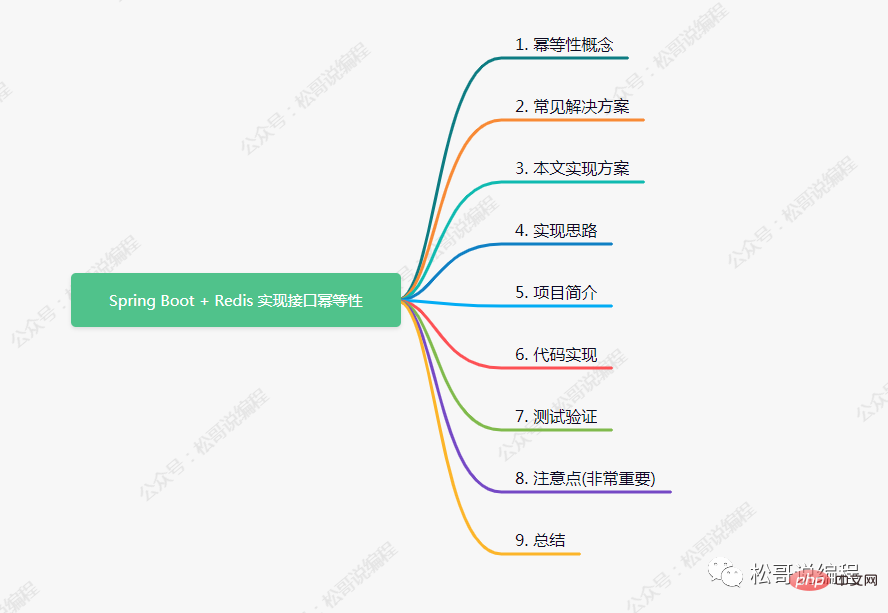
Idempotence, in layman’s terms, is an interface. If you initiate the same request multiple times, you must ensure that the operation can only be executed once. For example:
Order interface, orders cannot be created multiple times Payment interface, payment for the same order can only be deducted once Alipay callback interface, there may be multiple callbacks, and repeated callbacks must be processed Ordinary form submission interface, due to network timeout and other reasons, you can only click submit multiple times, and you can only succeed once. Wait
2. Common solutions
Unique index -- Prevent new dirty data Token mechanism-- Prevent page submission from repeated Pessimistic lock-- Lock when acquiring data ( Lock table or row) Optimistic lock--implemented based on version number, verify the data at the moment the data is updated Distributed Lock -- redis (jedis, redisson) or zookeeper implements State machine -- state change, determine the state when updating data
3. Implementation of this article
This article uses the second method to implement, that is, through the Redis token mechanism to achieve interface idempotence check.
4. Implementation Ideas
Create a unique identifier for each request that needs to ensure idempotence token, first obtain token, and store this token in redis. When requesting the interface, put this token in the header or as a request parameter to request the interface. The backend interface determines whether this token:
exists in redis
If it exists, process the business logic normally and delete this token from redis. Then, if it is a repeated request, since token has been deleted, then it cannot pass the verification and returns Do not repeat the operationPrompt -
If it does not exist, it means that the parameter is illegal or it is a repeated request, just return the prompt
5. Project Introduction
Spring BootRedis##@ApiIdempotentAnnotation interceptor intercepts requests @ControllerAdviceGlobal exception handling - Stress testing tool:
Jmeter
Note:
This article focuses on the core implementation of idempotence. The details of how Spring Boot integrates redis, ServerResponse, ResponseCode and other details are beyond the scope of this article.
6. Code implementation
1, mavenDependency
<!-- Redis-Jedis -->
<dependency>
<groupId>redis.clients</groupId>
<artifactId>jedis</artifactId>
<version>2.9.0</version>
</dependency>
<!--lombok 本文用到@Slf4j注解, 也可不引用, 自定义log即可-->
<dependency>
<groupId>org.projectlombok</groupId>
<artifactId>lombok</artifactId>
<version>1.16.10</version>
</dependency>Copy after login2. JedisUtil
@Component
@Slf4j
public class JedisUtil {
@Autowired
private JedisPool jedisPool;
private Jedis getJedis() {
return jedisPool.getResource();
}
/**
* 设值
*
* @param key
* @param value
* @return
*/
public String set(String key, String value) {
Jedis jedis = null;
try {
jedis = getJedis();
return jedis.set(key, value);
} catch (Exception e) {
log.error("set key:{} value:{} error", key, value, e);
return null;
} finally {
close(jedis);
}
}
/**
* 设值
*
* @param key
* @param value
* @param expireTime 过期时间, 单位: s
* @return
*/
public String set(String key, String value, int expireTime) {
Jedis jedis = null;
try {
jedis = getJedis();
return jedis.setex(key, expireTime, value);
} catch (Exception e) {
log.error("set key:{} value:{} expireTime:{} error", key, value, expireTime, e);
return null;
} finally {
close(jedis);
}
}
/**
* 取值
*
* @param key
* @return
*/
public String get(String key) {
Jedis jedis = null;
try {
jedis = getJedis();
return jedis.get(key);
} catch (Exception e) {
log.error("get key:{} error", key, e);
return null;
} finally {
close(jedis);
}
}
/**
* 删除key
*
* @param key
* @return
*/
public Long del(String key) {
Jedis jedis = null;
try {
jedis = getJedis();
return jedis.del(key.getBytes());
} catch (Exception e) {
log.error("del key:{} error", key, e);
return null;
} finally {
close(jedis);
}
}
/**
* 判断key是否存在
*
* @param key
* @return
*/
public Boolean exists(String key) {
Jedis jedis = null;
try {
jedis = getJedis();
return jedis.exists(key.getBytes());
} catch (Exception e) {
log.error("exists key:{} error", key, e);
return null;
} finally {
close(jedis);
}
}
/**
* 设值key过期时间
*
* @param key
* @param expireTime 过期时间, 单位: s
* @return
*/
public Long expire(String key, int expireTime) {
Jedis jedis = null;
try {
jedis = getJedis();
return jedis.expire(key.getBytes(), expireTime);
} catch (Exception e) {
log.error("expire key:{} error", key, e);
return null;
} finally {
close(jedis);
}
}
/**
* 获取剩余时间
*
* @param key
* @return
*/
public Long ttl(String key) {
Jedis jedis = null;
try {
jedis = getJedis();
return jedis.ttl(key);
} catch (Exception e) {
log.error("ttl key:{} error", key, e);
return null;
} finally {
close(jedis);
}
}
private void close(Jedis jedis) {
if (null != jedis) {
jedis.close();
}
}
}Copy after login3. Custom annotation @ApiIdempotent
/**
* 在需要保证 接口幂等性 的Controller的方法上使用此注解
*/
@Target({ElementType.METHOD})
@Retention(RetentionPolicy.RUNTIME)
public @interface ApiIdempotent {
}Copy after login4. ApiIdempotentInterceptor Interceptor
/**
* 接口幂等性拦截器
*/
public class ApiIdempotentInterceptor implements HandlerInterceptor {
@Autowired
private TokenService tokenService;
@Override
public boolean preHandle(HttpServletRequest request, HttpServletResponse response, Object handler) {
if (!(handler instanceof HandlerMethod)) {
return true;
}
HandlerMethod handlerMethod = (HandlerMethod) handler;
Method method = handlerMethod.getMethod();
ApiIdempotent methodAnnotation = method.getAnnotation(ApiIdempotent.class);
if (methodAnnotation != null) {
check(request);// 幂等性校验, 校验通过则放行, 校验失败则抛出异常, 并通过统一异常处理返回友好提示
}
return true;
}
private void check(HttpServletRequest request) {
tokenService.checkToken(request);
}
@Override
public void postHandle(HttpServletRequest httpServletRequest, HttpServletResponse httpServletResponse, Object o, ModelAndView modelAndView) throws Exception {
}
@Override
public void afterCompletion(HttpServletRequest httpServletRequest, HttpServletResponse httpServletResponse, Object o, Exception e) throws Exception {
}
}Copy after login5、TokenServiceImpl
@Service
public class TokenServiceImpl implements TokenService {
private static final String TOKEN_NAME = "token";
@Autowired
private JedisUtil jedisUtil;
@Override
public ServerResponse createToken() {
String str = RandomUtil.UUID32();
StrBuilder token = new StrBuilder();
token.append(Constant.Redis.TOKEN_PREFIX).append(str);
jedisUtil.set(token.toString(), token.toString(), Constant.Redis.EXPIRE_TIME_MINUTE);
return ServerResponse.success(token.toString());
}
@Override
public void checkToken(HttpServletRequest request) {
String token = request.getHeader(TOKEN_NAME);
if (StringUtils.isBlank(token)) {// header中不存在token
token = request.getParameter(TOKEN_NAME);
if (StringUtils.isBlank(token)) {// parameter中也不存在token
throw new ServiceException(ResponseCode.ILLEGAL_ARGUMENT.getMsg());
}
}
if (!jedisUtil.exists(token)) {
throw new ServiceException(ResponseCode.REPETITIVE_OPERATION.getMsg());
}
Long del = jedisUtil.del(token);
if (del <= 0) {
throw new ServiceException(ResponseCode.REPETITIVE_OPERATION.getMsg());
}
}
}Copy after login6、TestApplication
@SpringBootApplication
@MapperScan("com.wangzaiplus.test.mapper")
public class TestApplication extends WebMvcConfigurerAdapter {
public static void main(String[] args) {
SpringApplication.run(TestApplication.class, args);
}
/**
* 跨域
* @return
*/
@Bean
public CorsFilter corsFilter() {
final UrlBasedCorsConfigurationSource urlBasedCorsConfigurationSource = new UrlBasedCorsConfigurationSource();
final CorsConfiguration corsConfiguration = new CorsConfiguration();
corsConfiguration.setAllowCredentials(true);
corsConfiguration.addAllowedOrigin("*");
corsConfiguration.addAllowedHeader("*");
corsConfiguration.addAllowedMethod("*");
urlBasedCorsConfigurationSource.registerCorsConfiguration("/**", corsConfiguration);
return new CorsFilter(urlBasedCorsConfigurationSource);
}
@Override
public void addInterceptors(InterceptorRegistry registry) {
// 接口幂等性拦截器
registry.addInterceptor(apiIdempotentInterceptor());
super.addInterceptors(registry);
}
@Bean
public ApiIdempotentInterceptor apiIdempotentInterceptor() {
return new ApiIdempotentInterceptor();
}
}Copy after loginOkay, the above is the implementation part of the code. Next we Let’s verify it.
7. Test verification
Get the controller of tokenTokenController:
@RestController
@RequestMapping("/token")
public class TokenController {
@Autowired
private TokenService tokenService;
@GetMapping
public ServerResponse token() {
return tokenService.createToken();
}
}Copy after loginTestController, 注意@ApiIdempotent注解, 在需要幂等性校验的方法上声明此注解即可, 不需要校验的无影响:
@RestController
@RequestMapping("/test")
@Slf4j
public class TestController {
@Autowired
private TestService testService;
@ApiIdempotent
@PostMapping("testIdempotence")
public ServerResponse testIdempotence() {
return testService.testIdempotence();
}
}Copy after login获取token:

查看Redis:

测试接口安全性: 利用Jmeter测试工具模拟50个并发请求, 将上一步获取到的token作为参数


header或参数均不传token, 或者token值为空, 或者token值乱填, 均无法通过校验, 如token值为abcd。

8. Notes (very important)

jedisUtil.del(token) and directly release it, then there will still be a duplicate submission problem, even if there is actually only one real deletion operation, reproduce it below one time.
Modify the code slightly:



9. Summary
In fact, the idea is very simple, that is, each request is guaranteed to be unique, thereby ensuring idempotence Property, through interceptor annotation, you don’t need to write repeated code for every request. In fact, it can also be implemented using Spring AOP.
Okay, I’ll share it here today.
Redis token mechanism to achieve interface idempotence check. token, first obtain token, and store this token in redis. When requesting the interface, put this token in the header or as a request parameter to request the interface. The backend interface determines whether this token:token from redis. Then, if it is a repeated request, since token has been deleted, then it cannot pass the verification and returns Do not repeat the operationPromptSpring BootRedisAnnotation interceptor intercepts requests Global exception handlingmavenDependency<!-- Redis-Jedis -->
<dependency>
<groupId>redis.clients</groupId>
<artifactId>jedis</artifactId>
<version>2.9.0</version>
</dependency>
<!--lombok 本文用到@Slf4j注解, 也可不引用, 自定义log即可-->
<dependency>
<groupId>org.projectlombok</groupId>
<artifactId>lombok</artifactId>
<version>1.16.10</version>
</dependency>JedisUtil@Component
@Slf4j
public class JedisUtil {
@Autowired
private JedisPool jedisPool;
private Jedis getJedis() {
return jedisPool.getResource();
}
/**
* 设值
*
* @param key
* @param value
* @return
*/
public String set(String key, String value) {
Jedis jedis = null;
try {
jedis = getJedis();
return jedis.set(key, value);
} catch (Exception e) {
log.error("set key:{} value:{} error", key, value, e);
return null;
} finally {
close(jedis);
}
}
/**
* 设值
*
* @param key
* @param value
* @param expireTime 过期时间, 单位: s
* @return
*/
public String set(String key, String value, int expireTime) {
Jedis jedis = null;
try {
jedis = getJedis();
return jedis.setex(key, expireTime, value);
} catch (Exception e) {
log.error("set key:{} value:{} expireTime:{} error", key, value, expireTime, e);
return null;
} finally {
close(jedis);
}
}
/**
* 取值
*
* @param key
* @return
*/
public String get(String key) {
Jedis jedis = null;
try {
jedis = getJedis();
return jedis.get(key);
} catch (Exception e) {
log.error("get key:{} error", key, e);
return null;
} finally {
close(jedis);
}
}
/**
* 删除key
*
* @param key
* @return
*/
public Long del(String key) {
Jedis jedis = null;
try {
jedis = getJedis();
return jedis.del(key.getBytes());
} catch (Exception e) {
log.error("del key:{} error", key, e);
return null;
} finally {
close(jedis);
}
}
/**
* 判断key是否存在
*
* @param key
* @return
*/
public Boolean exists(String key) {
Jedis jedis = null;
try {
jedis = getJedis();
return jedis.exists(key.getBytes());
} catch (Exception e) {
log.error("exists key:{} error", key, e);
return null;
} finally {
close(jedis);
}
}
/**
* 设值key过期时间
*
* @param key
* @param expireTime 过期时间, 单位: s
* @return
*/
public Long expire(String key, int expireTime) {
Jedis jedis = null;
try {
jedis = getJedis();
return jedis.expire(key.getBytes(), expireTime);
} catch (Exception e) {
log.error("expire key:{} error", key, e);
return null;
} finally {
close(jedis);
}
}
/**
* 获取剩余时间
*
* @param key
* @return
*/
public Long ttl(String key) {
Jedis jedis = null;
try {
jedis = getJedis();
return jedis.ttl(key);
} catch (Exception e) {
log.error("ttl key:{} error", key, e);
return null;
} finally {
close(jedis);
}
}
private void close(Jedis jedis) {
if (null != jedis) {
jedis.close();
}
}
}@ApiIdempotent/**
* 在需要保证 接口幂等性 的Controller的方法上使用此注解
*/
@Target({ElementType.METHOD})
@Retention(RetentionPolicy.RUNTIME)
public @interface ApiIdempotent {
}ApiIdempotentInterceptor Interceptor/**
* 接口幂等性拦截器
*/
public class ApiIdempotentInterceptor implements HandlerInterceptor {
@Autowired
private TokenService tokenService;
@Override
public boolean preHandle(HttpServletRequest request, HttpServletResponse response, Object handler) {
if (!(handler instanceof HandlerMethod)) {
return true;
}
HandlerMethod handlerMethod = (HandlerMethod) handler;
Method method = handlerMethod.getMethod();
ApiIdempotent methodAnnotation = method.getAnnotation(ApiIdempotent.class);
if (methodAnnotation != null) {
check(request);// 幂等性校验, 校验通过则放行, 校验失败则抛出异常, 并通过统一异常处理返回友好提示
}
return true;
}
private void check(HttpServletRequest request) {
tokenService.checkToken(request);
}
@Override
public void postHandle(HttpServletRequest httpServletRequest, HttpServletResponse httpServletResponse, Object o, ModelAndView modelAndView) throws Exception {
}
@Override
public void afterCompletion(HttpServletRequest httpServletRequest, HttpServletResponse httpServletResponse, Object o, Exception e) throws Exception {
}
}TokenServiceImpl@Service
public class TokenServiceImpl implements TokenService {
private static final String TOKEN_NAME = "token";
@Autowired
private JedisUtil jedisUtil;
@Override
public ServerResponse createToken() {
String str = RandomUtil.UUID32();
StrBuilder token = new StrBuilder();
token.append(Constant.Redis.TOKEN_PREFIX).append(str);
jedisUtil.set(token.toString(), token.toString(), Constant.Redis.EXPIRE_TIME_MINUTE);
return ServerResponse.success(token.toString());
}
@Override
public void checkToken(HttpServletRequest request) {
String token = request.getHeader(TOKEN_NAME);
if (StringUtils.isBlank(token)) {// header中不存在token
token = request.getParameter(TOKEN_NAME);
if (StringUtils.isBlank(token)) {// parameter中也不存在token
throw new ServiceException(ResponseCode.ILLEGAL_ARGUMENT.getMsg());
}
}
if (!jedisUtil.exists(token)) {
throw new ServiceException(ResponseCode.REPETITIVE_OPERATION.getMsg());
}
Long del = jedisUtil.del(token);
if (del <= 0) {
throw new ServiceException(ResponseCode.REPETITIVE_OPERATION.getMsg());
}
}
}TestApplication@SpringBootApplication
@MapperScan("com.wangzaiplus.test.mapper")
public class TestApplication extends WebMvcConfigurerAdapter {
public static void main(String[] args) {
SpringApplication.run(TestApplication.class, args);
}
/**
* 跨域
* @return
*/
@Bean
public CorsFilter corsFilter() {
final UrlBasedCorsConfigurationSource urlBasedCorsConfigurationSource = new UrlBasedCorsConfigurationSource();
final CorsConfiguration corsConfiguration = new CorsConfiguration();
corsConfiguration.setAllowCredentials(true);
corsConfiguration.addAllowedOrigin("*");
corsConfiguration.addAllowedHeader("*");
corsConfiguration.addAllowedMethod("*");
urlBasedCorsConfigurationSource.registerCorsConfiguration("/**", corsConfiguration);
return new CorsFilter(urlBasedCorsConfigurationSource);
}
@Override
public void addInterceptors(InterceptorRegistry registry) {
// 接口幂等性拦截器
registry.addInterceptor(apiIdempotentInterceptor());
super.addInterceptors(registry);
}
@Bean
public ApiIdempotentInterceptor apiIdempotentInterceptor() {
return new ApiIdempotentInterceptor();
}
}tokenTokenController:@RestController
@RequestMapping("/token")
public class TokenController {
@Autowired
private TokenService tokenService;
@GetMapping
public ServerResponse token() {
return tokenService.createToken();
}
}TestController, 注意@ApiIdempotent注解, 在需要幂等性校验的方法上声明此注解即可, 不需要校验的无影响:@RestController
@RequestMapping("/test")
@Slf4j
public class TestController {
@Autowired
private TestService testService;
@ApiIdempotent
@PostMapping("testIdempotence")
public ServerResponse testIdempotence() {
return testService.testIdempotence();
}
}token: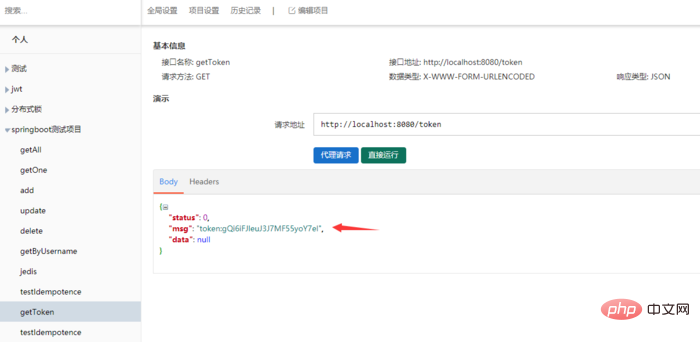
Redis: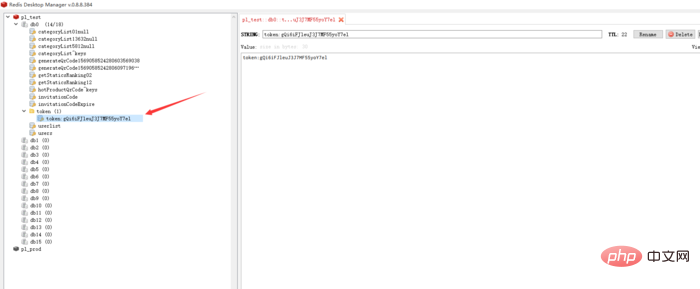
Jmeter测试工具模拟50个并发请求, 将上一步获取到的token作为参数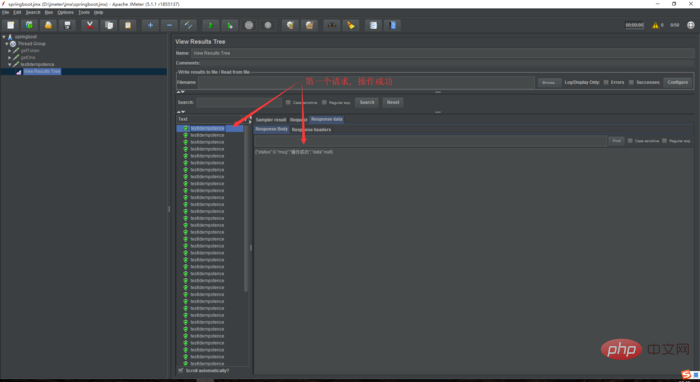
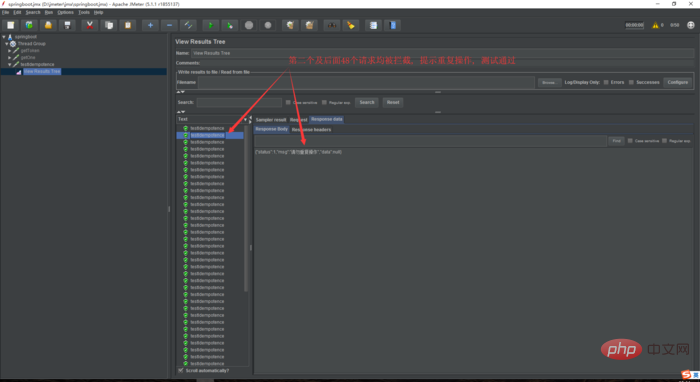
abcd。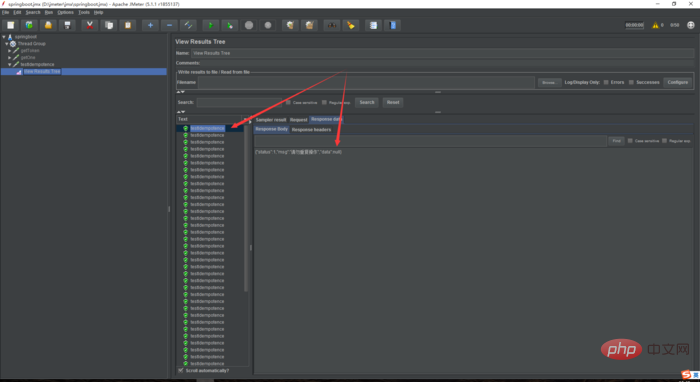
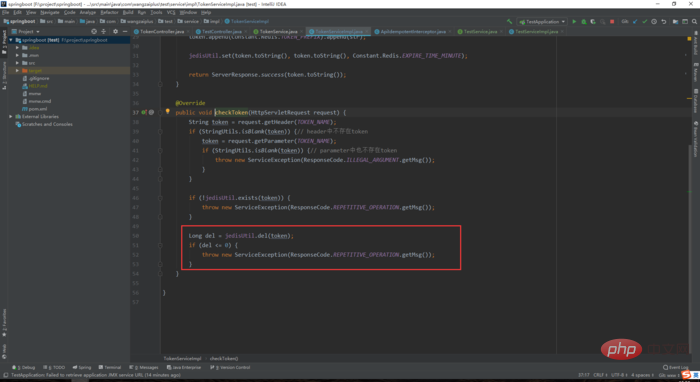
and directly release it, then there will still be a duplicate submission problem, even if there is actually only one real deletion operation, reproduce it below one time. 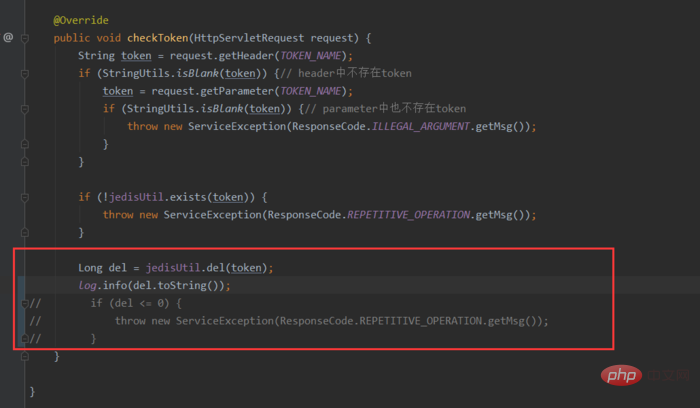

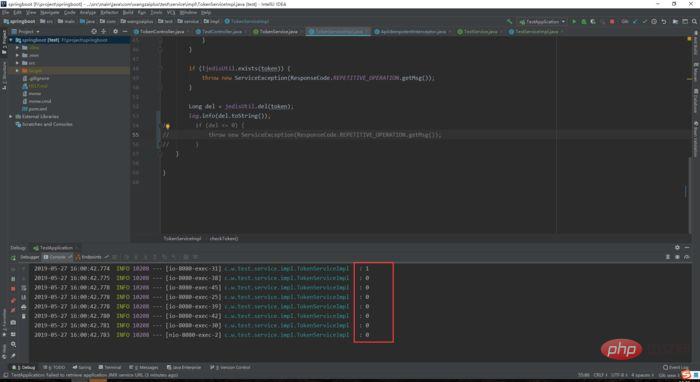
ensuring idempotence Property, through interceptor annotation, you don’t need to write repeated code for every request. In fact, it can also be implemented using Spring AOP. The above is the detailed content of Interviewer: In the payment interface, money can only be deducted once for repeated payments for the same order. How to do this?. For more information, please follow other related articles on the PHP Chinese website!

Hot AI Tools

Undresser.AI Undress
AI-powered app for creating realistic nude photos

AI Clothes Remover
Online AI tool for removing clothes from photos.

Undress AI Tool
Undress images for free

Clothoff.io
AI clothes remover

AI Hentai Generator
Generate AI Hentai for free.

Hot Article

Hot Tools

Notepad++7.3.1
Easy-to-use and free code editor

SublimeText3 Chinese version
Chinese version, very easy to use

Zend Studio 13.0.1
Powerful PHP integrated development environment

Dreamweaver CS6
Visual web development tools

SublimeText3 Mac version
God-level code editing software (SublimeText3)

Hot Topics
 Interviewer: Spring Aop common annotations and execution sequence
Aug 15, 2023 pm 04:32 PM
Interviewer: Spring Aop common annotations and execution sequence
Aug 15, 2023 pm 04:32 PM
You must know Spring, so let’s talk about the order of all notifications of Aop. How does Spring Boot or Spring Boot 2 affect the execution order of aop? Tell us about the pitfalls you encountered in AOP?
 Interview with a certain group: If you encounter OOM online, how should you troubleshoot it? How to solve? What options?
Aug 23, 2023 pm 02:34 PM
Interview with a certain group: If you encounter OOM online, how should you troubleshoot it? How to solve? What options?
Aug 23, 2023 pm 02:34 PM
OOM means that there is a vulnerability in the program, which may be caused by the code or JVM parameter configuration. This article talks to readers about how to troubleshoot when a Java process triggers OOM.
 Ele.me's written test questions seem simple, but it stumps a lot of people
Aug 24, 2023 pm 03:29 PM
Ele.me's written test questions seem simple, but it stumps a lot of people
Aug 24, 2023 pm 03:29 PM
Don’t underestimate the written examination questions of many companies. There are pitfalls and you can fall into them accidentally. When you encounter this kind of written test question about cycles, I suggest you think calmly and take it step by step.
 Novices can also compete with BAT interviewers: CAS
Aug 24, 2023 pm 03:09 PM
Novices can also compete with BAT interviewers: CAS
Aug 24, 2023 pm 03:09 PM
The extra chapter of the Java concurrent programming series, C A S (Compare and swap), is still in an easy-to-understand style with pictures and texts, allowing readers to have a crazy conversation with the interviewer.
 Last week, I had an interview with XX Insurance and it was cool! ! !
Aug 25, 2023 pm 03:44 PM
Last week, I had an interview with XX Insurance and it was cool! ! !
Aug 25, 2023 pm 03:44 PM
Last week, a friend in the group went for an interview with Ping An Insurance. The result was a bit regretful, which is quite a pity, but I hope you don’t get discouraged. As you said, basically all the questions encountered in the interview can be solved by memorizing the interview questions. It’s solved, so please work hard!
 5 String interview questions, less than 10% of people can answer them all correctly! (with answer)
Aug 23, 2023 pm 02:49 PM
5 String interview questions, less than 10% of people can answer them all correctly! (with answer)
Aug 23, 2023 pm 02:49 PM
This article will take a look at 5 interview questions about the Java String class. I have personally experienced several of these five questions during the interview process. This article will help you understand why the answers to these questions are like this.
 Meituan interview: Please handwrite a quick schedule, I was shocked!
Aug 24, 2023 pm 03:20 PM
Meituan interview: Please handwrite a quick schedule, I was shocked!
Aug 24, 2023 pm 03:20 PM
Quick sort was proposed by C. A. R. Hoare in 1962. Its basic idea is to divide the data to be sorted into two independent parts through one sorting. All the data in one part is smaller than all the data in the other part, and then use this method to quickly separate the two parts of the data. Sorting, the entire sorting process can be performed [recursively], so that the entire data becomes an ordered sequence.






